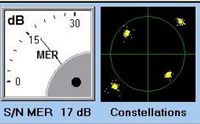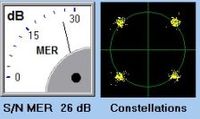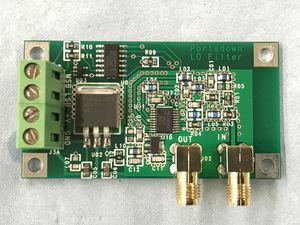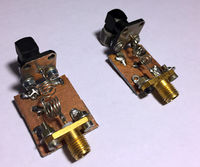LO filters
Testing on the 3 prototype boards has shown that, due to the square wave output of the ADF4351, it will need filtering between the output of the ADF4351 module and the modulator board LO input when used on 146 and 437 MHz. This filter only needs to be a simple low pass filter to remove the third harmonic and no filtering is required on 23cms.
The effect of running without a high pass filter on 146 and 437 is an imbalance in the modulator resulting in reduced MER and RF performance as seen on the screen shots below - it does not affect the transmitted spectrum and is OK to put on air.


Switched multi-band design
To simplify this problem the team have designed a small PCB which will switch in the correct filter for all 4 bands automatically based on commands from the RPi.
It is highly recommended that this filter is used with the Portsdown system - blank PCBs are available in the BATC shop and the parts list...
Tables showing the detailed performance and output power of the Portsdown modulator board with and without filtering on the LO input are available here.
Single-band Filters
For those who just want to operate on one band the project team have designed 2 simple single band filters which can be hand built very easily.
The left hand filter is for 146 MHz. It is series L, shunt C, series L in a T configuration. The inductors are each 4 turns of 24 swg tinned copper wire wound on a 4.5mm drill. The capacitor is 27 pf ceramic. The filter has 1.5 dB insertion loss at 146 MHz and >25 dB loss at 440 MHz. A "Black" eBay ADF4351 board typically gives -0.5 dBm when set to output level 3 at 146 MHz, so the input level to the modulator is -2 dBm, which is the recommended level.
The right hand filter is for 437 MHz. Same configuration, the inductors are 2 turns of 24 swg wound on a 3mm drill, and the capacitor is a 4.7 pf ceramic. The insertion loss at 437 MHz is 2 dB and the attenuation at 1300 MHz over 17 dB. The resulting input level to the modulator is about -2.5 dBm. Note that the inductors are at right angles to reduce cross-coupling.
Both filters raised the output MER to 26 dB (measured in MiniTioune 5a). Right-angled SMA chassis sockets were fitted to one end of each, so that they could connect directly to the modulator without another cable. No filter is required for 1255 MHz.
A filter has been tested for 71 MHz using a similar design. The inductors were each 6 turns of 24 swg tinned copper wire wound on a 4.5mm drill, and the shunt capacitor was 68 pf. The MER improvement was not so marked, because the modulator phase shift network is out of spec at this frequency. However, the signal is fit for transmission.
NOTE: These are simple low pass filters and not suitable to be used on the output of the modulator filter board - see this wiki page for filters designed for transmitter and receiver filtering.

